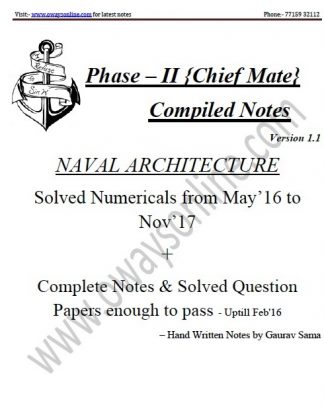Q) What are the Intact Stability requirements of Oil Tanker Ships
Ans:- Intact Stability requirements of Oil Tanker Ships: Oil tankers, as defined in the section Definitions, shall comply with regulation 27 (Intact Stability) of Annex I to MARPOL 73/78:-
- Every oil tanker of 5,000 tonnes deadweight and above delivered on or after 1 February 2002, as defined in regulation 1.28.7, shall comply with the intact stability criteria specified in paragraphs 1.1 and 1.2 of this regulation, as appropriate, for any operating draught under the worst possible conditions of cargo and ballast loading, consistent with good operational practice, including intermediate stages of liquid transfer operations. Under all conditions the ballast tanks shall be assumed slack.
- In port, the initial metacentric height GMo, corrected for the free surface measured at 0° heel, shall be not less than 0.15 m.
- At sea, the following criteria shall be applicable:
- the area under the righting lever curve (GZ curve) shall be not less than 0.055 m·rad up to θ = 30° angle of heel and not less than 0.09 m·rad up to θ = 40° or other angle of flooding θf* if this angle is less than 40°. Additionally, the area under the righting lever curve (GZ curve) between the angles of heel of 308 and 40° or between 30° and θf, if this angle is less than 40°, shall be not less than 0.03 m·rad;
- the righting lever GZ shall be at least 0.20 m at an angle of heel equal to or greater than 30°;
- the maximum righting arm shall occur at an angle of heel preferably exceeding 30° but not less than 25°; and
- the initial metacentric height GMo, corrected for free surface measured at 0° heel, shall be not less than 0.15 m.
- The requirements of paragraph 1 of this regulation shall be met through design measures. For combination carriers simple supplementary operational procedures may be allowed.
- Simple supplementary operational procedures for liquid transfer operations referred to in paragraph 2 of this regulation shall mean written procedures made available to the master which:
- are approved by the Administration.
- Indicate those cargo and ballast tanks which may, under any specific condition of liquid transfer and possible range of cargo densities, be slack and still allow the stability criteria to be met. The slack tanks may vary during the liquid transfer operations and be of any combination provided they satisfy the criteria;
- will be readily understandable to the officer-in-charge of liquid transfer operations;
- provide for planned sequences of cargo/ballast transfer operations;
- allow comparisons of attained and required stability using stability performance criteria in graphical or tabular form;
- require no extensive mathematical calculations by the officer-incharge;
- provide for corrective actions to be taken by the officer-incharge in case of departure from recommended values and in case of emergency situations; and
- are prominently displayed in the approved trim and stability booklet and at the cargo/ballast transfer control station and in any computer software by which stability calculations are performed.
Q) Describe the precautions to be taken while carrying out inclining test.
Ans:- Precautions to be taken while carrying out Inclining Test:
- The ship must be moored in quiet sheltered waters free from the effects of passing vessels.
- There must be adequate depth of water under the keel so that the bottom of the ship does not touch the sea bed on inclination.
- There should little or no wind. If there is any wind the ship should be head on or stern to it.
- The ship should be floating free. There should be no barges alongside.
- Moorings should be slackened right down.
- Shore side gangway if any must be landed to allow unrestricted heeling.
- All loose weights must be removed or secured.
- All fittings and equipments such as accommodation ladder , derricks/cranes should be stowed in their normal sea going positions.
- Free surface should be minimized. All tanks should be verified as being completely empty or full. Bilges should be dry.
- Deck should be free of water. Any water trapped on deck will move during the test and reduce the accuracy of the result.
- The ship should be upright at the commencement of the experiment.
- All personnel not directly concerned with the experiment should be sent ashore.
- In tidal conditions, conduct experiment at slack water.

